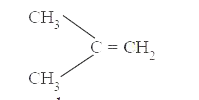Arrange the following in the increasing order of stability.
CH3CH2CH=CH2,CH3CH=CHCH3(cis),CH3CH=CHCH3 (trans)
 Solution in Bengali
Solution in Bengali
CH3CH2CH=CH2<(CH3)CH=CH2CH3 (cis)<(CH3)2C=CH2<CH3CH=CHCH3 (trans)
Topper's Solved these Questions
- ISOMERISM IN ORGANIC CHEMISTRYBOOK - NCERT BANGLISHCHAPTER - ISOMERISM IN ORGANIC CHEMISTRYEXERCISE - SELF EVALUATION (GEOMETRICAL ISOMERISM(Practice Question))
5 Videos
- ISOMERISM IN ORGANIC CHEMISTRYBOOK - NCERT BANGLISHCHAPTER - ISOMERISM IN ORGANIC CHEMISTRYEXERCISE - SELF EVALUATION (CONFORMATION)
2 Videos
- ISOMERISM IN ORGANIC CHEMISTRYBOOK - NCERT BANGLISHCHAPTER - ISOMERISM IN ORGANIC CHEMISTRYEXERCISE - SELF EVALUATION (CONFORMATION(Short answer questions.))
2 Videos
- HYDROXY DERIVATIVESBOOK - NCERT BANGLISHCHAPTER - HYDROXY DERIVATIVESEXERCISE - Phenols
10 Videos
- NUCLEAR CHEMISTRYBOOK - NCERT BANGLISHCHAPTER - NUCLEAR CHEMISTRYEXERCISE - SELF EVALUATION
31 Videos
Similar Questions
Draw the cis, trans isomers for the following and designate them as E or Z.
View SolutionWhich among the following can have different conformations ?
CH4
CHCl3
CH3COOH
CH3CH2OH
View SolutionDistinguish enantiomers and diasteromers ?
View SolutionHow can the following be obtained ?
(a) phenol from benzene diazonium chloride
(b) 2, 4, 6-tribromo phenol from phenol
View SolutionThe phenomenon of radioactivity was discovered by
View SolutionWhich of the following alkanes can exhibit cis-trans isomerism? (i) CH_(2) = CHCH_(2)CH_(3) , (ii) CH_(2) = C(CH_(3))_(2) (iii) CH_(3)CH=CHCH_(3) , (iv) CH_(3)CH_(2)CH=CHCl
View SolutionExplain the formation of the products in the following reaction.
CH3CH=CHCH2Br+H2O→CH3CH=CHCH2OH+CH3CH(OH)CH=CH2.
View SolutionArrange the following compounds in increasing order of S_(N^(1)) reactivity. (a). (I). ClCH_(2)CH=CHCH_(2)CH_(3) , (II). CH_(3)C(Cl)=CHCH_(2)CH_(3) , (III). CH_(3)CH=CHCH_(2)CH_(2)Cl (b). (I). CH_(3)CH_(2)Br , (II). CH_(2)=CHCH(Br)CH_(3) , (III). CH_(2)=CHBr, (IV). CH_(3)CH(Br)CH_(3) (c). (I). (CH_(3))_(3)CBr , (II). (CH_(3))_(2)CHBr , (III). CH_(3)CH_(2)CH_(2)Br ,
View SolutionThe compounds CH_(3)CH = CHCH_(3) and CH_(3)CH_(2)CH = CH_(2)
View Solutionनिम्नलिखित यौगिकों के आई.यु.पी.ए.सी.नाम लिखिए |
(i) (CH3)2CH−CH=CH−CH3−CH || CH3−CH−CH ∣ C2H5
(ii)
CH2=C(CH2CH2CH3)2
(iv) CH3CH2CH2 CH2CH2CH3 | | CH3−CHCH=C−CH2−CHCH3 ∣ CH3
View SolutionArrange the following in order of increasing stability :
CH3CH−2,CH≡C−,CH2=CH−
View Solutionनिम्नलिखित यौगिकों को SN1 क्रियाशीलता के बढ़ते हुए क्रम में व्यवस्थित कीजिए -
(a) ClCH2CH=CHCH2CH3,CH3C(Cl)=CHCH2CH3,CH3CH=CHCH2CH2Cl(b) CH3CH2Br,CH2=CHCH(Br)CH3,CH2=CHBr,CH3CH(Br)CH3(c) (CH3)3CCl,C6H5C(CH3)2Cl,(CH3)2CHCl,CH3CH2CH2Cl
View Solutionनिम्नलिखित अभिक्रिया मे उत्पाद के निर्माण की व्याख्या कीजिए -
CH3CH=CHCH2Cl+H2O→CH3CH=CHCH2OH+CH3CH(OH)CH=CH2
View SolutionArrange the following carbanions in order of their decreasing stability.
A) H3C−C≡C−
B) H−C≡C−
C) H3C−C¯¯¯¯H2
View SolutionWrite the IUPAC names of the compound CH_(2)=CHCH_(2)CH_(2)C-=CH&CH_(3)CH=CHCH_(2)C-=CH
View Solution
